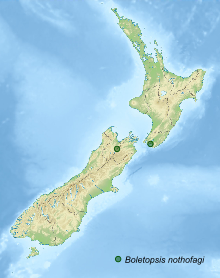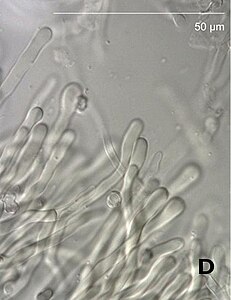Boletopsis nothofagi
| Boletopsis nothofagi | |
|---|---|

| |
| Scientific classification | |
| Domain: | Eukaryota |
| Kingdom: | Fungi |
| Division: | Basidiomycota |
| Class: | Agaricomycetes |
| Order: | Thelephorales |
| Family: | Bankeraceae |
| Genus: | Boletopsis |
| Species: | B. nothofagi
|
| Binomial name | |
| Boletopsis nothofagi J.A.Cooper & P.Leonard (2012)
| |
Boletopsis nothofagi is a
). It is unknown when exactly the fungus forms its fruit body, but it has so far been found solely in May, during autumn in the Southern Hemisphere.The first
Taxonomy
|
In 2009, an unknown species of
Boletopsis nothofagi is a genetically clearly differentiated representative of the genus Boletopsis, which according to the investigations of Cooper and Leonard separated relatively early from the precursor of most other known species. Only a North American species, B. leucomelaena, branches off from their phylogenetic tree even earlier. However, the relationships between many of the species were not fully resolved in the study, so in the future, new species may be described.[3]
Description

The fruit bodies of Boletopsis nothofagi usually grow in tufts and only rarely individually. They have a centrally stalked cap. The cap is convex, measuring 10–80 mm (0.4–3.1 in) wide and 5–22 mm (0.2–0.9 in) high. In young specimens, the cap's edge is slightly bent, whereas the cap of older fruit bodies often curl. The cap cuticle is gray in color, and its texture ranges from smooth to slightly fibrous. Pressure- or scrape-spots are stained darker and eventually blacken.[4]
The stipes are club-shaped to cylindrical, slightly tapering towards both base and cap, with a height of about 20–60 mm (0.8–2.4 in) and a thickness of 10–25 mm (0.4–1.0 in). The stipe is smooth and dry on the surface and has a firm texture on the inside. The stipes have a similar color as the cap and shows the same responses to damage.[4]
The white, porous hymenium has a thickness of 1–2 mm and turns brown when bruised. Per millimeter, there are two to three square pores. When dried, the hymenium's color becomes pinkish-brown. The hymenium extends slightly down the stipe, and is sharply defined. Dried tissue smells similar to fenugreek. The morphology of the mycorrhiza has not yet been described; however, as with all other types of Boletopsis it is likely to be ectomycorrhizal.[4]
Microscopic characteristics
Boletopsis nothofagi has a
- Microscopic structures
-
Cystidia-like structures
-
Hyphae with clamp connections
-
Spores
Distribution

The known range of Boletopsis nothofagi is limited to two narrowly defined areas of New Zealand, one on the
Boletopsis nothofagi is the most southern member of the genus Boletopsis, and as of 2013 the sole known member of the genus in the Southern Hemisphere; its closest relatives are found in Asia and Costa Rica.[5]
Ecology
The occurrence of Boletopsis nothofagi seems to be strongly connected to the occurrence of the southern beech Nothofagus fusca, a species of Fagales that is endemic to New Zealand. B. nothofagi has been found exclusively in N. fusca forests spread through New Zealand below 37° S. The fungus forms a mycorrhizal association with the trees of N. fusca, in which the hyphae of the fungal mycelium wrap around the roots of the tree and penetrate the cortex, but not its cells. Subsequently, B. nothofagi takes over the function of the root hair and directs water and soil nutrients to the tree. In return, the fungus can, through contact with the root tissue, access the products of the tree's photosynthesis. The fruit bodies of the species have so far always been found in May, the end of autumn in the Southern Hemisphere.[4]
Little is known about the habitat requirements – such as humidity, temperature, soil composition and water content – of B. nothofagi. However, as the species seems to only occur together with N. fusca, it should largely conform to their demands. The tree species prefers lowlands and hills along river valleys and usually grows on nutrient-rich, well-drained soil. The species is more likely to be found inland than in the coastal regions.[6]
Status
According to Cooper and Leonard, the fact that Boletopsis nothofagi was only found 200 years after the European settlement of New Zealand illustrates the rarity of this species, although it is also possible that the late discovery was caused by rare or infrequent fructification. The authors assume that the species occurs very sparsely and that this cannot be attributed to human activity. Although no data on population trends or historical distribution of the fungus exists, Cooper and Leonard consider the species in accordance to the New Zealand Threat Classification System as "naturally uncommon".[7]
References
- ^ . Retrieved 12 November 2021.
- ^ Cooper & Leonard (2012) pp. 13–20.
- ^ Cooper & Leonard (2012) pp. 16–27.
- ^ a b c d e Cooper & Leonard (2012) p. 18
- ^ a b Cooper & Leonard (2012) pp. 16–18.
- ^ Nelson; Marlborough Conservancy (2006). Beech forest – Biodiversity (PDF) (Report). Department of Conservation. Government of New Zealand. Archived from the original (PDF) on 2013-10-05.
- ^ Cooper & Leonard (2012) pp. 18–21.
Cited literature
- Cooper, Jerry; Patrick Leonard (2012). "Boletopsis nothofagi sp. nov. associated with Nothofagus in the Southern Hemisphere". MycoKeys. 3: 13–22. ISSN 1314-4057.

External links





